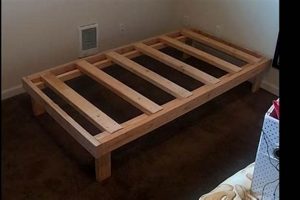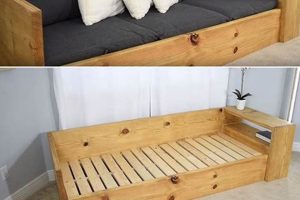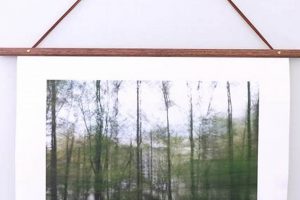A structure designed to hold fabric taut during the quilting process, constructed by the user rather than purchased pre-made, enables precise stitching and intricate designs. These homemade apparatuses often utilize readily available materials such as wood, PVC pipes, or repurposed furniture, offering a cost-effective alternative to commercially manufactured options. For instance, a basic model might consist of four wooden rails joined at the corners to form a rectangular frame, providing a stable surface for layering fabric and batting.
The practice of creating one’s own support for quilting projects offers several advantages. It facilitates personalized sizing to accommodate projects of varying scales, from miniature wall hangings to expansive bed covers. The ability to customize the construction also allows for adaptation to individual workspaces and ergonomic needs. Historically, resourceful individuals have always crafted their own tools and implements, including those used for textile arts. This tradition reflects a commitment to self-sufficiency and a deep understanding of the craft.
The following sections will delve into the specific types of such structures, detailing construction methods, material considerations, and techniques for maximizing their effectiveness in supporting a range of quilting endeavors. Careful planning and execution are key to creating a functional and durable support system for successful quilting projects.
Tips for Constructing a Quilting Support Structure
Optimizing the construction process leads to a stable and efficient platform for quilting. The following tips outline key considerations for building a durable and functional framework.
Tip 1: Material Selection: Choose wood or PVC pipes based on project size and desired portability. Hardwoods provide stability for larger quilts, while PVC offers a lightweight option for smaller projects or limited space.
Tip 2: Accurate Measurements: Precise measurements are critical for square corners and a taut fabric surface. Imperfections in the frame’s geometry will translate to difficulties in quilting evenly.
Tip 3: Secure Joinery: Employ strong joinery techniques, such as mortise and tenon or reinforced screws, to ensure the frame’s structural integrity. A wobbly frame compromises quilting precision.
Tip 4: Fabric Tensioning Mechanism: Incorporate a system for adjusting fabric tension. Ratcheting mechanisms or simple clamps can maintain consistent tension as quilting progresses.
Tip 5: Smooth Surface Finish: Sand all surfaces thoroughly to prevent snagging of fabric. A smooth finish allows the fabric to glide freely as it is being quilted.
Tip 6: Consider Ergonomics: Design the height and angle of the structure to minimize strain during extended quilting sessions. Adjustability is beneficial for diverse physical needs.
Tip 7: Portability Considerations: If mobility is desired, consider a design that can be easily disassembled or folded for storage and transport. This is particularly useful for quilters with limited workspace.
Adhering to these construction guidelines promotes the creation of a robust and user-friendly quilting apparatus, contributing significantly to the overall quality and enjoyment of the quilting experience.
The subsequent sections will address advanced techniques and troubleshooting methods for maximizing the functionality of user-built quilting supports.
1. Frame Stability
Frame stability is a foundational attribute of any quilting support structure, directly influencing the quality and ease of the quilting process. When considering user-constructed quilting supports, this attribute becomes paramount, as stability is not guaranteed but rather a direct outcome of design and construction choices.
- Material Rigidity
The inherent stiffness of the chosen materials dictates the frame’s resistance to bending and warping. Hardwoods, for example, provide superior stability compared to softer woods or lightweight PVC, particularly when supporting larger or heavier quilt projects. Inadequate material rigidity can lead to frame deflection, causing uneven tension across the quilt and hindering precise stitching.
- Joint Integrity
The strength and stability of the joints connecting the frame’s components are critical for maintaining its overall structural integrity. Weak or poorly constructed joints introduce points of instability, allowing the frame to flex or even collapse under pressure. Techniques such as mortise and tenon joints or reinforced screw connections are essential for achieving robust joint integrity, especially in larger quilting frames.
- Bracing and Reinforcement
Strategic bracing and reinforcement can significantly enhance the stability of a quilting frame. Cross braces, corner gussets, or diagonal supports can be incorporated to distribute weight and minimize flexing. These additions are particularly important for frames constructed from less rigid materials or designed to support large or heavy quilts. Failure to adequately brace a frame can result in instability and compromised stitching accuracy.
- Base Support and Leveling
A stable and level base is crucial for preventing wobbling or tilting during the quilting process. Adjustable feet or leveling mechanisms can compensate for uneven floor surfaces, ensuring that the frame remains securely positioned. Insufficient base support can lead to frame instability, making it difficult to maintain consistent stitch tension and control.
The preceding factors underscore the critical connection between frame stability and the success of any quilting project undertaken using a user-constructed apparatus. By carefully considering material properties, joint construction, bracing techniques, and base support, quilters can create a stable and reliable support system that facilitates precision and enhances the overall quilting experience.
2. Fabric Tension
Maintaining appropriate fabric tension is a critical aspect of the quilting process, directly impacting stitch quality and the overall appearance of the finished piece. Within the context of a user-constructed support, achieving consistent and adjustable fabric tension presents unique challenges and opportunities.
- Tensioning Mechanisms
User-built supports often incorporate a variety of tensioning mechanisms, ranging from simple clamp systems to more elaborate ratcheting devices. These mechanisms serve to stretch the fabric taut within the frame, minimizing puckering and wrinkles that can interfere with accurate stitching. The effectiveness of the tensioning mechanism is directly proportional to its ability to maintain consistent pressure across the fabric surface over extended periods. An example is using canvas stretching pliers to hold fabric tightly to the frame before using a clamp system to make it easier to quilt.
- Material Elasticity and Drift
The chosen fabric and batting materials exhibit varying degrees of elasticity, which can affect tension consistency over time. Natural fibers, for instance, may stretch or relax under tension, requiring periodic adjustments to maintain optimal tightness. Furthermore, the phenomenon of “tension drift” refers to the gradual loosening of fabric tension due to material creep or slippage within the frame. Effective tensioning systems must account for material elasticity and minimize tension drift to ensure uniform stitch quality.
- Frame Design and Geometry
The overall design and geometry of the user-constructed support play a crucial role in distributing tension evenly across the fabric. A frame with insufficient rigidity may flex or warp under tension, leading to localized areas of increased or decreased tightness. Conversely, a well-designed frame with proper support and bracing will distribute tension uniformly, promoting consistent stitch quality. The rectangular frame is most common for its ability to create even tension with adjustable sides.
- Adjustment and Monitoring
Effective fabric tension management necessitates regular adjustment and monitoring throughout the quilting process. Visual inspection, tactile assessment, and specialized tension gauges can be employed to detect and correct tension imbalances. User-built systems often require more frequent adjustments compared to commercially manufactured frames, as they may lack automated tensioning features. Quilters are advised to develop a keen awareness of fabric tension and implement proactive adjustment protocols to maintain optimal stitching conditions.
The facets discussed illustrate the intrinsic connection between fabric tension and the construction of quilting supports. Optimal tension is not merely a byproduct of the frame but a function of deliberate design, material selection, and vigilant monitoring. User-built frames require a hands-on approach to tension management, emphasizing the quilter’s role in achieving consistent, high-quality results.
3. Size Customization
The capacity for size customization represents a primary advantage when constructing a quilting support independently. Standard, commercially available frames often impose dimensional limitations, restricting the scale of projects that can be accommodated. User-constructed alternatives, however, grant the quilter the freedom to tailor the frame’s dimensions to precisely match the intended size of the quilt. This adaptability is particularly crucial for undertaking projects of unconventional proportions, such as king-size bed quilts or irregularly shaped wall hangings.
The ability to specify frame dimensions directly influences the quilting process. A frame that is too small can necessitate frequent repositioning of the fabric, disrupting workflow and potentially introducing inconsistencies in stitch tension. Conversely, a frame that is excessively large may prove unwieldy and difficult to maneuver, particularly in limited workspaces. Size customization ensures an optimal balance between fabric support and frame manageability, promoting efficiency and accuracy. For instance, a quilter creating miniature quilts might opt for a small, lightweight frame constructed from PVC pipes, while a quilter working on large-scale tapestries could choose a robust wooden frame with extended dimensions.
In summary, the link between size customization and do-it-yourself construction is significant. It enables the creation of frames tailored to specific project requirements, thereby enhancing quilting precision, workflow efficiency, and overall project outcomes. While this customization demands careful planning and execution, the benefits in terms of project scope and creative flexibility are considerable.
4. Material Cost
Material cost represents a primary driver behind the decision to construct a quilting support independently. Commercially manufactured frames, particularly those with advanced features such as adjustable height or automated tensioning mechanisms, often carry a substantial price tag. Constructing a support from readily available materials, such as lumber, PVC pipe, or repurposed furniture components, presents a cost-effective alternative, especially for quilters on a limited budget. The extent of cost savings is directly proportional to the complexity of the desired design and the resourcefulness in sourcing materials. For example, a basic frame constructed from repurposed wood may cost only a fraction of a commercially available model, while a more elaborate design incorporating specialized hardware could approach a similar price point.
The composition of material costs within this context warrants specific consideration. Lumber prices fluctuate based on species, grade, and region. PVC pipe offers a lower-cost alternative for smaller, lighter frames. Fasteners, such as screws and bolts, represent a minor but necessary expense. Specialized hardware, such as ratcheting tensioners or adjustable feet, can significantly increase the overall material cost. Furthermore, the cost of tools, such as saws, drills, and measuring devices, should be factored in, particularly if these items must be purchased specifically for the project. Ultimately, a detailed cost analysis, comparing the expenses of materials against the price of a comparable commercial frame, is crucial for determining the true economic benefit of independent construction.
In summation, material cost is a pivotal determinant in the decision to undertake the construction of a quilting support independently. While the potential for cost savings is significant, a thorough assessment of material requirements, sourcing options, and tool investments is essential for making an informed choice. The economic advantages of constructing a quilting frame must be weighed against the time, skill, and effort required to complete the project successfully. Achieving a balance between cost-effectiveness and quality construction is the key to maximizing the benefits of this approach.
5. Ergonomic Design
Ergonomic design principles are critically relevant when constructing a quilting support independently. The prolonged and repetitive nature of quilting tasks can place significant strain on the body, making ergonomic considerations paramount for preventing discomfort, fatigue, and potential musculoskeletal injuries. User-constructed supports offer the opportunity to tailor the frame’s design to individual physical needs and preferences, optimizing posture, reach, and overall comfort.
- Adjustable Height
A key ergonomic feature is adjustable height, allowing the quilter to position the fabric at an optimal level that minimizes bending or stooping. Prolonged periods of working in a hunched position can lead to back pain, neck stiffness, and other postural problems. Adjustable height mechanisms, such as telescoping legs or threaded supports, enable the user to customize the frame’s height to their specific stature and working preferences. This adaptation reduces strain on the back and promotes a more upright and comfortable posture. For instance, a taller quilter may require a higher frame setting than a shorter individual to maintain proper spinal alignment.
- Tilt and Angle Adjustment
The ability to tilt or angle the quilting surface represents another important ergonomic consideration. A tilted surface can reduce the strain on the wrists and hands by promoting a more neutral wrist position during stitching. Tilting the frame can also improve visibility and access to the fabric, minimizing the need to lean forward or crane the neck. User-constructed supports can incorporate hinges or pivoting mechanisms that allow for easy adjustment of the quilting surface angle, catering to individual preferences and task requirements. Some quilters find that a slight upward tilt reduces wrist fatigue, while others prefer a flat surface for certain stitching techniques.
- Reach and Accessibility
The overall dimensions and configuration of the frame should be designed to optimize reach and accessibility to all areas of the quilt. An overly large or complex frame can require excessive reaching, stretching, and twisting, increasing the risk of muscle strain. User-constructed supports can be tailored to minimize reach distances and ensure that all parts of the quilt are easily accessible without requiring awkward or uncomfortable movements. The design should also consider the quilter’s dominant hand and preferred stitching direction, positioning the fabric and tools for optimal efficiency and comfort. For example, a frame with a narrow profile may be preferable for quilters with shorter arms, as it reduces the need to reach across a wide surface.
- Integrated Support Features
User-constructed quilting supports can incorporate integrated support features to further enhance ergonomics. Padded armrests can reduce pressure on the elbows and forearms, minimizing discomfort and fatigue. Built-in tool trays or storage compartments can keep essential supplies within easy reach, eliminating the need to get up and move around frequently. Footrests or platforms can provide additional support and stability, promoting better posture and reducing strain on the legs and feet. These integrated features can significantly improve the overall comfort and usability of the quilting support, enabling the quilter to work for extended periods with reduced risk of injury.
In conclusion, the principles of ergonomic design are integral to the successful construction of a quilting support independently. By carefully considering height adjustability, tilt and angle adjustment, reach and accessibility, and integrated support features, quilters can create a frame that promotes comfort, reduces strain, and enhances their overall quilting experience. The flexibility of user-constructed supports allows for a high degree of customization, enabling quilters to tailor the frame to their unique physical needs and preferences, ultimately contributing to a more enjoyable and sustainable quilting practice.
6. Portability
The attribute of portability significantly impacts the utility of a user-constructed quilting support, particularly for individuals with limited workspace or those who frequently relocate their crafting activities. A quilting apparatus that can be easily disassembled, folded, or transported offers increased flexibility, allowing quilters to pursue their craft in diverse environments. The correlation between portability and independent construction is direct; the design choices made during the construction process dictate the ease with which the support can be moved or stored. For example, a frame constructed from lightweight PVC pipes with snap-together connectors is inherently more portable than a solid wood frame with permanently affixed joints. The practical significance of this portability lies in the ability to participate in quilting retreats, workshops, or simply relocate the project from one room to another without significant physical strain or logistical challenges.
Further analysis reveals that portability is not solely determined by weight. The overall dimensions and configuration of the disassembled or folded frame are equally important. A frame that breaks down into numerous small components might be lightweight but cumbersome to transport due to the increased number of individual pieces. Conversely, a frame that folds into a compact unit, even if heavier, might be easier to manage. Design considerations, such as integrated carrying handles or rolling casters, can further enhance portability. An example of practical application is a user-built frame designed with hinged sections that allow it to fold flat for storage under a bed or against a wall when not in use, maximizing space efficiency in smaller living environments.
In summary, the connection between portability and self-built quilting frames is defined by design choices that directly impact the user’s ability to move and store the support. The challenge lies in balancing portability with stability and functionality. Achieving this balance requires careful consideration of material selection, joint construction, and overall frame geometry. A well-designed, portable quilting support offers significant advantages in terms of flexibility and convenience, aligning with the broader theme of resourcefulness and customization inherent in the do-it-yourself approach to quilting equipment.
7. Ease of Assembly
Ease of assembly represents a significant factor in the practicality and accessibility of self-constructed quilting supports. The complexity of the assembly process directly influences the time investment required to set up and dismantle the frame, impacting the user’s willingness to utilize it regularly. A design prioritizing ease of assembly promotes frequent and efficient use, maximizing the benefits of the constructed support.
- Component Simplicity
The number and complexity of individual components directly affect the ease of assembly. Designs utilizing a minimal number of parts, such as pre-cut lumber sections or standardized PVC fittings, streamline the assembly process. Conversely, frames requiring intricate joinery or specialized hardware demand greater skill and time. For example, a simple A-frame design may consist of only six pieces, while a more elaborate multi-rail system can involve dozens of components, each requiring precise alignment and fastening. Reduction of steps in assembly and reducing the number of tools for construction allows a quicker build.
- Tool Requirements
The types and number of tools required for assembly dictate the accessibility of the project to individuals with varying levels of experience and resources. Frames requiring only basic tools, such as a screwdriver, wrench, or rubber mallet, are generally easier to assemble than those necessitating specialized equipment like power saws or pneumatic nailers. The need for complex tool handling and the use of additional assistance can complicate build.
- Assembly Instructions Clarity
Clear, concise, and well-illustrated assembly instructions are crucial for guiding the user through the construction process. Ambiguous or incomplete instructions can lead to frustration, errors, and potentially unsafe construction practices. Instructions incorporating step-by-step diagrams, parts lists, and troubleshooting tips significantly enhance the ease of assembly. Online guides or video tutorials can serve as valuable supplementary resources for visual learners.
- Joint Design
The type of joint used significantly affects the ease with which frame sections can be joined. Simple joints that need to be secured with screws, nuts and bolts, or snap-fit connectors are straightforward. Mortise-and-tenon or dovetail joints require precision fitting and can involve advanced woodworking skills.
The preceding points underscore the importance of ease of assembly in the context of homemade quilting frames. A user-friendly assembly process translates to increased utilization, reduced frustration, and greater overall satisfaction with the constructed support. Balancing ease of assembly with stability, functionality, and cost-effectiveness remains a key consideration in the design and construction of a successful do-it-yourself quilting support.
Frequently Asked Questions
The following questions address common concerns and misconceptions regarding the construction and use of homemade quilting supports. The aim is to provide clear, concise information to facilitate informed decision-making.
Question 1: What are the primary advantages of a self-constructed quilting support versus a commercially available option?
The primary advantages include cost savings, size customization, and the ability to tailor the design to individual ergonomic needs and workspace constraints. Self-construction allows for precise dimensional control and material selection unavailable in many pre-fabricated options.
Question 2: What are the essential tools required for building a basic structure?
Essential tools typically include a saw (hand or power), a drill with various drill bits, a measuring tape, a level, sandpaper, and appropriate fasteners such as screws or bolts. Depending on the design, a square and clamps may also be necessary.
Question 3: What materials are most suitable for creating a durable and stable frame?
Hardwoods such as oak or maple offer superior stability for larger quilts. Softwoods like pine are suitable for smaller projects. PVC pipe provides a lightweight and cost-effective alternative, although it may lack the rigidity of wood for larger applications.
Question 4: How is fabric tension maintained and adjusted on a self-built quilting support?
Fabric tension can be maintained through various mechanisms, including clamps, ratcheting systems, or fabric rollers. Consistent tension is crucial for preventing puckering and ensuring even stitch distribution. Frequent adjustments may be necessary depending on fabric elasticity and environmental conditions.
Question 5: What are the key considerations for designing an ergonomically sound structure?
Ergonomic considerations include adjustable height, a tilted work surface, and appropriate reach distances to minimize strain on the back, neck, shoulders, and wrists. The design should promote a comfortable and sustainable working posture for extended quilting sessions.
Question 6: How does one address issues of wobbling or instability in a homemade support?
Wobbling or instability can often be rectified by reinforcing joints, adding cross braces, ensuring a level base, and using higher-quality materials. Careful attention to accurate measurements and secure connections during construction is paramount for preventing such issues.
In summary, self-constructed quilting structures offer numerous benefits but require careful planning and execution. Addressing stability, tension, ergonomics, and cost-effectiveness is essential for achieving a satisfactory outcome.
The subsequent section will explore advanced construction techniques and troubleshooting strategies for optimizing the performance of user-built supports.
Conclusion
The preceding sections have explored the multifaceted aspects of diy quilting frame construction. Stability, tensioning mechanisms, size customization, material costs, ergonomic considerations, portability, and ease of assembly represent critical determinants of a successful outcome. Thoughtful planning, meticulous execution, and a thorough understanding of quilting principles are essential for maximizing the benefits of a self-built support.
The continued development and refinement of diy quilting frame designs hold significant potential for democratizing access to quilting and fostering innovation within the craft. Further research and experimentation in material science, engineering principles, and ergonomic design can yield even more effective and user-friendly solutions. Individuals are encouraged to share their knowledge and experiences to advance the state of the art in this field.







